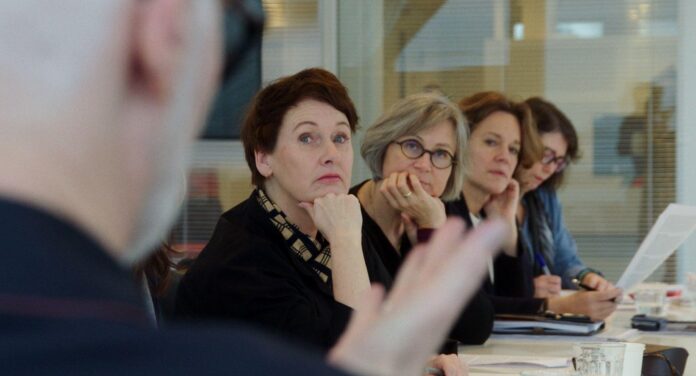Over the past decade, museums the world over—but especially in Europe and North America—have taken more or less active steps to redress blind spots and systemic shortcomings in their collecting, hiring and operating practices. These reforms have been initiated or spurred along by pressures both internal and external. These institutional changes are at the center of Sarah Vos’s documentary White Balls on Walls, which examines how one museum—the Stedelijk Museum Amsterdam—actually does the work of trying to change from the inside out.
The film is set against the backdrop of the pandemic, as the museum’s new director, Rein Wolfs, settles into the role and attempts to radically shift the culture at the museum. It offers an unflinching view of how questions about inclusion are discussed and turned into policy, who decides which artists’ works are acquired and featured in museum exhibitions, and who is in the room when these decisions are made.

Stedelijk director Rein Wolfs in a scene from White Balls on Walls (2022) Courtesy Zeppers Film, NTR and Icarus Films
The opening scene features a meeting between Wolfs and Amsterdam’s deputy mayor, who emphasises to the museum director that to maintain its funding, the Stedelijk must address all of Amsterdam’s citizens. Specific questions are raised: How can we tackle diversity issues in art? And how can we deal with gender issues in art? Vos follows along as Wolfs debates and dissects these questions with his staff over the following months. This in turn leads to complicated questions about labels, titles of paintings and the context in which they are viewed today, political correctness and how the museum positions itself on all these issues.
Vos’s almost total access to the museum’s staff over several months conveys the minutiae that comes with running a museum—the countless meetings and day-to-day activities—but also how they attempt to put a diversity and inclusion plan into action, with Wolfs setting out ambitious goals. What the museum’s leaders and workers are trying to do is no easy task, and doing it in real time in front of a film crew adds another layer of tension.

A scene from White Balls on Walls (2022) Courtesy Zeppers Film, NTR and Icarus Films
Vos makes a point of focusing on language, particularly as the nearly all-white are attempting to create inclusive structures. The museum’s curators want to overhaul their acquisitions policies to the point that half their collection is by artists who are of neither Western European nor North American origin, but can’t decide if “origin” or “background” is the right word choice. This spirals into questions within questions that the staff struggle to answer and untangle.
Early on in his tenure, Wolfs hires Charl Landvreugd, a Black man, to be the museum’s head of research and curatorial practice in an effort to diversify the staff. Vos devotes a good amount of the documentary to Landvreugd, his approaches to art and how to tackle the challenges facing the museum. This raises important issues around emotional labour given Landvreugd’s position as the prominent person of colour on staff who has been tasked with helping to diversify the museum. Tensions develop as the museum’s white administrators unpack their own issues related to gender and race in often-uncomfortable ways.

A scene from White Balls on Walls (2022) Courtesy Zeppers Film, NTR and Icarus Films
Wolfs, as the de facto protagonist, is disarmingly funny and direct, and seems to thrive under pressure. Even so, White Balls on Walls is tedious in parts and requires a great deal of attention on the part of viewers to simultaneously follow what is happening within the Stedelijk and in the larger cultural context of the Netherlands and beyond. The film offers a glimpse at the inner workings of an art museum struggling to implement change. For Wolfs and his staff to allow themselves to be filmed throughout this difficult process is generous and also at times feels like a social experiment to see how much they can accomplish under a microscope.
The power that museums wield, their inner workings and the never-accomplished task of better serving their communities are very complicated issues to address, especially in a nuanced and compelling way. Vos’s film provides vital context as it tracks the uncomfortable, unglamorous business of shifting museum culture.
- White Balls on Walls, now playing at Film Forum in New York and opening 2 June at the Laemmle Royal in Los Angeles

























